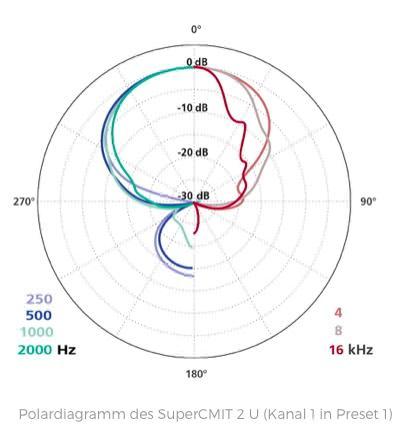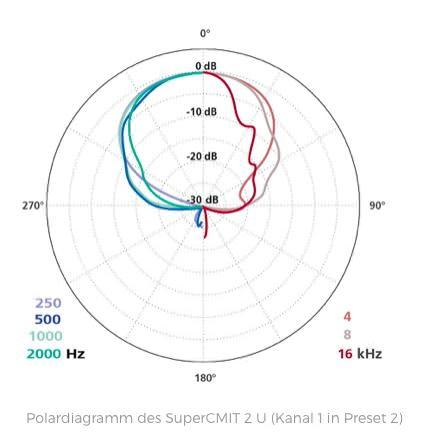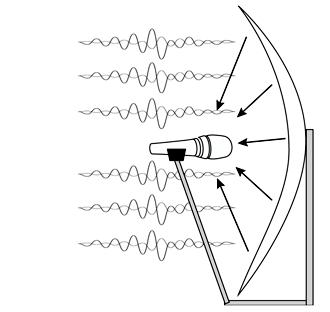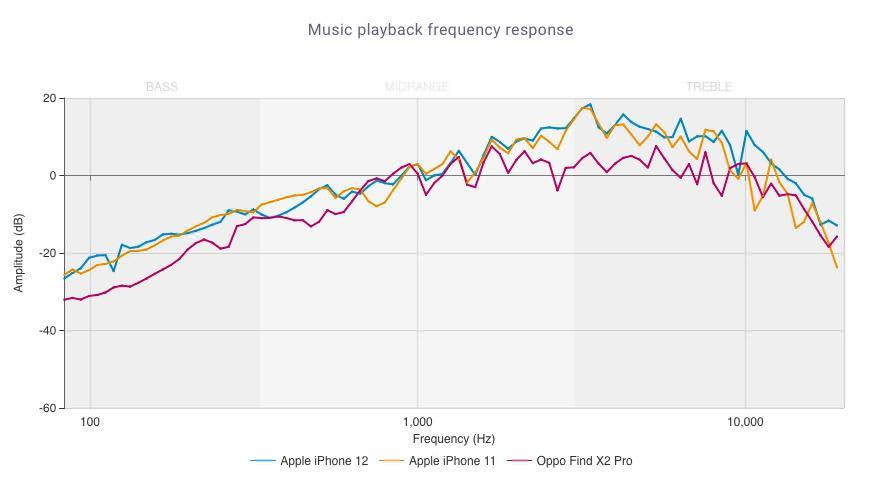
DHB
Members-
Posts
56 -
Joined
-
Last visited
Content Type
Forums
Gallery
Store
Everything posted by DHB
-
Yup, most manufacturers do it ..just look at the difference between the Schoeps SuperCMIT in its ordinary 'Preset 1' mode (which provides some reduction in rear sensitivity over other shotguns) and 'Preset 2' (rather more severe cutback) which almost totally eliminates rear sensitivity (but makes the mic sound rather 'boxy' as if in a small almost anechoic room ..that's if used indoors, of course)..
-
Try a proper Rycote 'zeppelin' with a full size 'dead cat' furry cover over it. Your mic needs to be properly isolated within an area of still air, then it shouldn't be affected.
-
Here's a picture - courtesy of B&H - showing a mic pointing INTO the centre of a parabolic dish, where the dish focuses the audio.. That's how the mic catches the focused audio ..pointing INTO the dish.
-
If that 2nd picture is your mic in front of a parabolic dish, then your mic is the wrong way round! (The mic should point INTO the dish, at the 'focal point' of the dish ..where the dish focuses the sound. Put your head in front of the dish, with one ear pointing into the dish, then move your head towards, into, and away from the dish until you hear the LOUDEST sound, then put the mic inside the dish (using an arm on your mic stand) until the HEAD of the mic is at the exact same point where your own ear was, then slide the mic in and out of the dish slightly until you hear in your cans the strongest, loudest sound. That's the 'focal point' of the dish, and that's where your mic should be, pointing ..INTO the dish.
-
I'd have thought that for bees - unless you want the distant sound of them heading towards or away from a hive, plus outdoor stereo ambience - the best thing is to lower a small-head wide-stereo mic (Audio-Technica AT825 or similar) into the hive. That way you'd have an 'intimate' broad stereo-soundscape, sounding like bees are almost inside your own head.
-
I've just tried my Fetheads and Fethead Phantoms on 24v as well as 48v. Both types of Fetheads (inc Phantoms) work perfectly well on 24v. (I tested with a Neumann 103 which - surprise to me! - also worked on 24v, and with a no-need-for-power Senn 421). I heard no detectable difference when equip't was used on 48v OR 24v. YMMV (..Your Microphone(s) May Vary).
-
"..for side, this will NOT do ANYTHING remotely related to the whole Side trick.." Absolutely, but I was thinking of a widely-spaced PAIR of dishes, to give a semblance of stereo, and pointed towards whatever inspire wants to capture. But, as I said, it'd be a bit difficult, with stereo dishes, to follow anything that's moving. (inspire wanted, preferably, to use Mid/Side, but I do realise that'd not be practicable with such a setup, so I was suggesting stereo as a fall-back.)
-
inspire says "..I want to push the boundaries, for example, if the source is much further away (hundreds of meters, for instance)". I think what you really need, if you're recording from those distances, is (for stereo or M/S) a couple of parabolic reflectors. They contribute NO noise (they're not electronic) so whatever electronic audio boost you might use - if that's even necessary with a couple of dishes - they will NOT boost any electronic noise. But at those distances you'd need very careful aiming. And it'd be a bit difficult, with stereo dishes, to follow anything that's moving! (Must be a big zoo - safari park? - if the creatures are that far away.)
-
"Okay. gotta ask. why?" Maybe I can explain: Frequency Response - 10Hz to 20kHz (±1db). I'm not sure what other recording devices ..apart from Sony's consumer DAT devices, and the brilliant miniature Sony NT recorders.. genuinely record as low as 10Hz (think steam-driven fairground organs), AES/EBU In and Out, Time Code sync (on the 1000TC version), Mid/Side monitoring (on the 1000TC Plus version). It's not a mixer, of course, and it doesn't have radio receivers. But - for me, anyway - the sound quality is absolutely superb ..in my experience (with Studers, etc) absolutely unbeatable in a portable machine.
-
EV made a few massive ones, plus the 644 (optionally) handheld ..ooh, mustn't go off-topic. I think we must admire the Franken-mic-assembly above.
-
Yes, I know a great repairman, but he's in Ireland, so postage, Customs, etc may be pricey ..but if it's worth it to you he'll do a brilliant job (did for mine last year, anyway!) ..he's Paul Carrington (a radio veteran) and email him first instead of just sending it: paulcarrington@btinternet.com He may need a bit of persuading, and he may say that he's not doing them any more. But if you're friendly, and give him lots of background info, he may do it. (It may be something just as simple as a stretched loading belt; that'll prevent the tape being loaded, and thus nothing else will work.) Tell him what the "..weird message on the screen.." says, and he may be able to diagnose it immediately.
-
If you're running a VP-88 on its internal battery, then ordinary Fetheads will boost the output but do NOT let phantom power go up the cable and to the mic itself, which is what you'd want (as if using non-phantom-powered dynamics or ribbons). But if you're running the VP-88 - or any mic - on phantom power, then Fethead Phantoms WILL allow phantom power up the cable to power the mic(s). I think they're pretty good ..same as 'Cloudlifters', but smaller and they fit inline just like normal XLR connectors. NOTE, though, that they'll amplify whatever's coming down the line from the mic(s), so if you've a lot of unwanted background noise they will, of course, also boost that, as they don't filter anything out. The boost effect is a bit like using a telephoto lens on a camera: the boosted audio seems to bring everything closer ..and certainly LOUDER!
-
Add a couple of Fetheads?
-
"..if you love fig8 for music I recommend the Beyer M130 if you do not know it. Old concept ribbon mike but beautiful along with the M160 in an MS setup.." Shure VP-88. The description on Shure's - and others' - website doesn't do it justice: "The Shure Model VP88 is a single-point, stereo condenser microphone" ..no, it's more than that: it's a Mid-Side mic with one capsule pointing straight ahead, and a dual-element sideways capsule delivering stereo (adjustable) width plus that central cardioid capsule filling in the centre. Wonderful breadth and depth.
-
Building a Binaural Headset-mount for DPA 4060 Lavs?
DHB replied to D Clay Audio's topic in Equipment
Martin Mitchell, here in the UK, https://martinmitchellsmicrophones.wordpress.com/2023/08/ tried a pair of Roland CS-10EM Binaural Microphones/Earphones last August, and added a couple of recordings to his web-page. These Roland earbud mics cost only about £80 (US$100) ..and I've just seen a used pair on eBay for £60 (US$75). The quality is really good (I have a pair), but - as DocSoundGuy says - although played back thro' earbuds the sound is immersive, with over-ear cans instead, or standard loudspeakers, the effect is more dispersed, 'lighter-weight' or rather tinny. With buds stuffed in your ears, reproduction does sound as if the listener is really there, but without having that replay sound stuffed straight down your own ear canals, you miss much of the immersiveness. But they're a cheap and great way to experiment - instead of buying a Zylia 19-mic golfball! -
B-but there's one being sold with 2x Wisycom receivers by Prosound (Europe) right now for US $2250.22 (£1,987.00) "Sonosax SX-RX8+ Dual Superslot Wireless Module" SONOSAXSKU: SX-RX8P-42-42 (And the postage to U$ can't possibly be $1750! ..Maybe check other prices elsewhere?)
-
Rereading what you've said: "..my Nova2 can power AES42 directly ... but it still requires a custom-built breakout cable that hangs awkwardly off my recorder.." ..custom-built? Short - or longer - AES cables are readily available on Amazon (that's where I got my long AES cable) and for short cables it's generally agreed, I think, that standard XLR cables do the job with no problem. I don't understand "..hangs awkwardly off my recorder". "..I think what I'm hearing is room echo that was bouncing back into the mic via the rear of the mic. This caused a doubled image and some phase distortion (at least, that is how I hear it)". Well, I wouldn't know; I don't really know what your room's like. "..I think I could still discern the reflection off the pavement at times. It's possible the effect is better described as an echo, but "phasey" is what I ended up settling on". Ah, an echo. Well, I get that indoors - except in Preset 2 mode - but I haven't heard it outdoors. If I did, I'd move the mic elsewhere. "..I dispute the assumption that it [Preset 2] would have made a whole lot of difference in the context that you are talking about (indoor ambience level)". Oh, but it does make a difference indoors; a much 'drier' and more isolated sound, with much less echo and ambience - though sometimes, as you put it, more 'phasey'. If the background sounds don't change, and the mic position and the source (person) don't change, then the 'phasiness' generally - in my experience anyway - goes away. ".. I don't know what to tell you other than listen at a higher level (which will reveal more detail), and focus more on the outdoor recordings where the differences are bigger". I think I'd better magnify (-s-t-r-e-t-c-h-) the waveforms in Audacity, and see if I can then notice any visible differences. None yet. Somehow I think you're missing a trick; there is, for me, quite a difference between Processed Preset 1 (reduced rear ambience) and Unprocessed Preset 1, which gives normal CMIT, I guess, which I find pretty much indistinguishable from, say, an unwieldy long NTG-8, for example. But, as Simon Says, better get it serviced, and then listen for differences.
-
"..Audacity doesn't read BWF metadata.." ..Good to know, thanks! "..I believe I added in the realm of 12dB gain during my listening.." ..I added 13 to 15. "..Maybe try headphones?.." ..of course. I wasn't listening thro' the MacBook speakers! (I used Senal 1000 ..same as Sony 7506, or whatever they're called). I'll listen again thro' some other software instead of Audacity. But gotta sleep now ..Z-z-z-z-z-z..
-
A few points, DocSG ..You say - in your 11-page comparison - that the SuperCMIT "..is awkward to use because it outputs AES42 digital audio rather than analogue". That depends on how you connect it to your recorder. If you plug it into an AES42 connection (in your recorder, supplying 10v straight into the mic) you get the processed signal and the unprocessed version as two separate inputs into your recorder. You can then define, say, Processed as Input 1, and Unprocessed as Input 2. Ditto if you power it via Schoeps' PSD 2 U box, into which you feed, say, 12v from a PowerBank batt or other source. If you power it via Schoeps' Mini-DA42 and the provided breakout cables (three of them, attached to the Mini-DA42 box) then you get an AES output (containing both the Processed and Unprocessed, as above) and you also get an ANALOGUE Processed output, and also an ANALOGUE Unprocessed output. So what you get depends NOT on the mic, but on which Schoeps box you use to connect the mic to the recorder. Point 2: You say (page 1) that "..both channels of the SuperCMIT sounded noticeably phasey or indistinct; all the other mics sounded much clearer". If you were COMBINING the two outputs of the SCMIT then you'd definitely get "phasey", as the Processed channel output is a fraction of a millisecond delayed with regard to the Unprocessed channel, as it takes a moment to create the Processed output. If you're listening to both simultaneously there's certainly a "phasey" difference; the Processed output IS, by necessity, out-of-phase with the Unprocessed audio. Point 3: In your "Indoor Test, no background music", I couldn't understand WHICH of the 5 mics I was listening to. They're not labelled - at least, not in my version of Audacity. And you don't say how far away you are from the mics ..3 feet? ..5 feet, or what? The 2nd mic, in my Audacity playback - on first listening - seemed to have less b/g hum than the others, but all are so -l-o-w- that I had to boost them all to detect any differences. And then, all boosted by the same amount, I couldn't detect any differences. (Maybe there's something odd about the uploaded file, or the way that I'm playing it as five separate tracks in my 'Audacity'.) Point 4: In your "Indoor Test, no background music", I similarly couldn't tell any difference between any of the mics; maybe that's an oddity of your file, or your methodology, or MY methodology in replaying the files. You say "..One thing that surprised me was that there was almost no difference in the amount of rejection between the microphones". Not only can I not hear any differences between the mics, but - in Audacity - there are no VISIBLE differences between the different tracks: the files have unpacked into five tracks ..but they are all identical. You say "..The processed SuperCMIT rejected slightly more noise than the others, but only by a decibel or two. In my opinion, this isn’t enough to matter". Weird. You didn't test Preset 2 ..that would have made A WHOLE LOT of difference ..unless there's something odd about the way the audio's presented in my MacBook from your downloadable files . Lastly, your Analysis, or conclusion, about the SuperCMIT is "The noise-cancellation has a couple other effects as well: It suppresses reverb along with everything else, which makes it terrible for reproducing a sense of space (realism), but very good at creating a dry recording that is perfect for sound effects and post-processing. It brings the on-axis sound perceptually closer (because the relative level of direct and indirect sound is part of how we perceive distance). Put another way, the SuperCMIT has more “reach” than just about any mic I’ve heard, at least when used in an open space. I was able to zoom in on sounds in a way that other mics aren’t capable of." That's exactly my opinion, too ..but - oddly - I couldn't hear any of that in the files which I downloaded. I wonder what I'm doing wrong..
-
Essentially (..sorry!..) the H6 Essential seems to have LOST the H6's useful gain knobs, but Zoom says "For full control of your mix, hit the ‘Mixer’ button and quickly adjust your levels". But that appears to mean one input at a time, using just one knob on the side of the box ..OR using Bluetooth to an iPhone or iPad displaying virtual faders, to adjust individual levels with as many fingers as you can use simultaneously. (But you'd need to buy the separate BT adaptor for that.) So adjusting levels looks more finicky than with the original H6 ..unless you're using 32-bit, in which case I s'pose the idea is that you don't need to adjust levels at all, as it'll never overload or distort. (But if you're not using 32-bit, you WOULD need to adjust levels.) The F6, of course, does have level-adjustment knobs, even though it, too, can use 32-bit. As for your battery problems, have you set - in the H6 Menu - the TYPE of batts you're using, so that it'll give a reasonably accurate estimate of battery level, remaining power, etc? [MENU > Cog Wheel (Date/Time) > Battery (type). And have you made sure that the battery contacts are not loose, so failing to keep proper contact? My own preference - if you're buying a new device - would be for the F6 (or the different-shape F8), as the H6 Essential looks (to me) too finicky if you'll be adjusting levels on the go. But I've never used one. Other people may give different advice.
-
SimonSays (..if you're still there..) and Waywardtoy, as you're both in London and having difficulties, you could speak with Mike Harris - though I don't know if he works on Nagras as old as the III ( he's at https://www.exprorecorders.uk/index2.html ) Mike is at Shepperton - or for a complete service (and I reckon he can thoroughly recondition your Nagras) call Petronel Butuc, he's at https://www.audiophilesclinic.co.uk in Kent. Mike may be a bit slow, but reasonable prices; Petronel is a wizard, but costs a bit more ..but can restore any Nagra to factory fresh condition.
-
Oh, right, thanks. "..so I can record simultaneously to a digital recorder (spdr or nagra) and my iphone". $Umpteen to record to.. ..an iPhone? (iPhone freq response chart from DxOMark.) Many thanks for the reply.
-
Er, maybe I'm a bit dim, but, er, why the two-input Sonosax as well as the 6-input Nagra VI..? Where does the output of the (non-recording, purely pre-amp) Sonosax go? Into one or two of the Nagra inputs? ..If so, why? Many thanks.
-
Those "..old Senn K3U.." and K6U cardioid mics were surprisingly good ..better than one would expect, anyway. And the (optionally) battery-powered Shure VP-88 was, and is, a great 'true' M/S mic. Then, of course, there was the (optionally) PP3-battery-powered Sony C38b studio mic ..and the 2x-PP3-rechargeable-battery-powered deep bass CAD e300² (recharges via phantom) ..but I'm getting off-topic.. Time for bed, G'nite!
-
I dunno; I simply read the documentation. Why don't you ask the people who designed it? sales@teenage.engineering [ P.S: If I do use electrets which don't have their own power, and I plug them into sockets which don't supply any power, I feed them through a small connector which DOES supply power, as, for example, with the old 'Vivanco'-brand teeny lapel/'lav' EM35 or EM216 miniature double-omni stereo mics. Ditto the 9v-needed AKG condenser mics with an XLR on the end: I use an AKG old inline supply box which runs off a 9v PP3 battery. Really easy. ]






